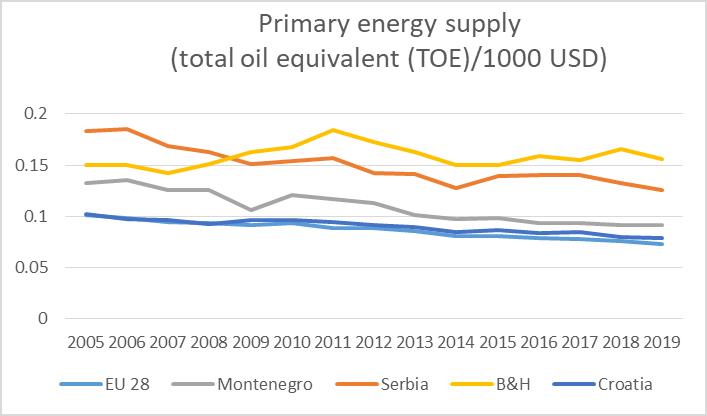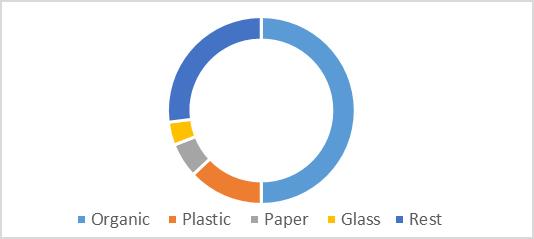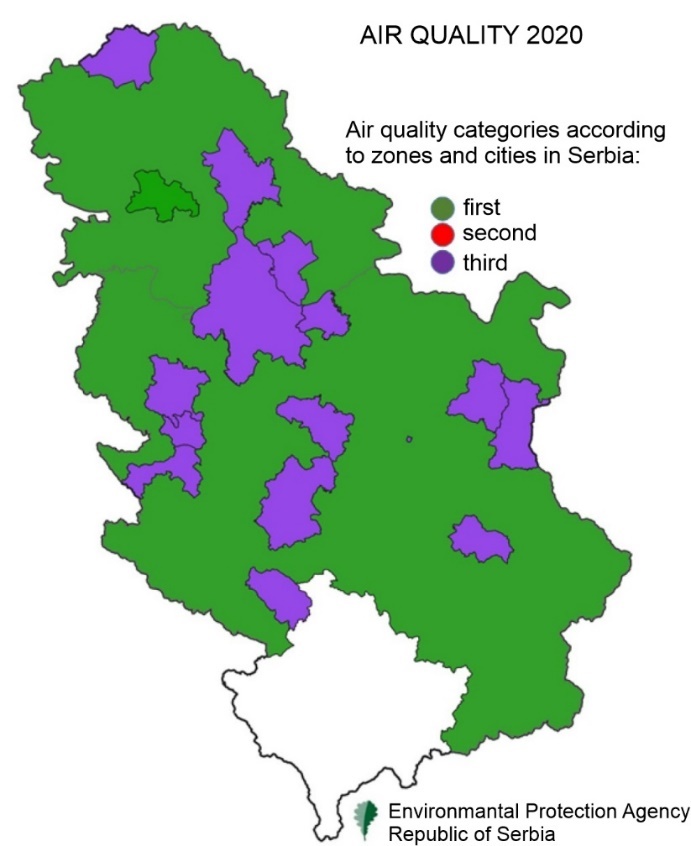Serbia’s environmental challenges are many and reforming the policies and institutions as well as allocating funding for implementation remains a challenge.
While Serbia lacks a designated fund to allocate special purpose revenues to environmental, renewable energy, and energy efficiency measures, estimated expenditures allocated to the “environmental protection budgetary function” amounted to about 0.3% of GDP in 2019. The Fiscal Council noted the need to increase this to about 1.2–1.4% of GDP.3 While expenditures on environmental protection remain low, Serbia continues to allocate substantial resources to subsidies for coal and lignite producers, which heavily distort competition and prices. Serbia is second only to Bosnia-Herzegovina in the region, in terms of direct subsidies per 1 MWh produced (see graph). As a total allocation, this represented EUR 41.36 million in direct payments.
Energy intensity remains exceptionally high in Serbia. As shown in Figure bellow, measured in “ton of oil equivalent (toe)” per thousand USD, it stood at 1.26 in 2019 against 0.073 in the EU, higher than in any of the other Western Balkan countries (except Bosnia and Herzegovina). In terms of total primary energy supply (TPES), Serbia satisfies most of its electricity demand from domestic production, with a high share of fossil fuels (88%), including almost 50% from coal), while significant improvements are needed in emissions reduction (e.g. through energy efficiency, retrofitting buildings, and electrification).

Climate change
At the Climate Ambition Summit 2020, the GoS reiterated its ambition to reduce GHG emissions by 33.3% compared to 1990 levels. One year later, at the UNFCCC COP26, Serbia failed to submit: an updated Nationally Determined Contribution; its long-term GHG emission development strategy towards a just transition to net zero, by or around mid-century; and its climate adaptation plan.
Waste management
Municipal waste production in Serbia appears comparable to that of neighbouring countries. The amount of waste generated has increased, but per capita generated communal waste is believed to be lower than the EU-28 average (Eurostat 2019).4 Recent estimates from a pilot study conducted in Belgrade, however, reveal a more nuanced picture, placing the city at the high end of European average values. Households in the capital currently generate about 165,838 tons of food waste (edible and inedible) annually, corresponding to 108.1 kg per capita per year, of which 27.7 kg is edible and 80.4 kg inedible. To assess, monitor and reduce food waste, similar research should be conducted on a national scale.5
Currently, Serbia’s recycling rate of municipal waste is significantly lower than in EU countries. In 2020, the total treated waste was 55.9 million tons, with 96% landfilled, 3% recycled and 0.2% used for energy production (SORS 2021g). Figure 8 shows the potential for recycling and composting or anaerobic digestion. Limited waste recovery remains a concern. In addition to the need to complete the legislative and policy framework, Serbia’s non-compliant landfills must be closed, waste reduction, separation, and recycling prioritised, and measures taken to treat medical and hazardous waste.

Source: SEPA, State of the Environment Report in the Republic of Serbia for 2020 (MEP and SEPA 2021)
According to the Institute of Public Health, in 2021, approximately 70% of city water supply systems provided drinking water of adequate quality, while 30% was inadequate with physical-chemical properties (8.33%), microbiological properties (9.62%), or both (13.46%) (IPH 2021). Investment in water infrastructure ranks among Serbia’s key needs, at almost EUR 6 billion.
Air quality
Air pollution has recently gained attention in public discourse and in national policies. Serbia faces significant air quality challenges, due to the use of solid fuel-based (traditional biomass and fossil fuels) heating in individual households and public buildings, industrial emissions (including thermal power plants), increased urban road traffic, and frequent landfill fires. Contributing to the problem, a high percentage of households – 48% in the general population and 88% in Roma settlements – still use unclean fuels and technologies for heating, cooking and lighting (SORS and UNICEF 2020).
According to estimates from the UN Environment Programme (UNEP) and WHO, each year, 1,004 deaths in Belgrade can be attributed to exposure to air pollution (Čolović Daul et al. 2019); and 6,394 deaths were attributed to air pollution in urban areas across the country in 2016. According to the European Environment Agency, Serbia ranks first in Europe for the number of years of life lost due to PM2.5 exposure per 100,000 inhabitants (EEA 2020) and SO2 pollution levels are not declining (ECS 2020). Non-compliance with sulphur dioxide and dust emissions resulted in the initiation of a case by the Secretariat of the Energy Community against Serbia in 2021.

Source: GoS 2021e, page 21.
Biodiversity
Biodiversity in Serbia is rich in quality but not quantity. The GoS plans to extend the landmass under protection. Just 7.66% of Serbia’s landmass is under protection in 469 areas6 , while legislation envisages an increase in protected areas.7 According to Serbian law8 , 1,760 species are under strict protection and 868 are under a protected regime. Almost all mammal, bird, amphibian, and reptile species are under protected regime, as well as a vast number of insect and plant species. More than 50% of strictly protected species are on the list of international conventions and EU Directives, most of which are in the Bern Convention, the Bonn Convention, or the Bird Directive.
Forests account for 2.3% of the national GDP and cover 28.1% of the country’s total area. Many of the forests in Serbia are in hilly or mountainous regions, which complicates optimal forest management. There are significant variations in forest coverage, which ranges from 6% in Vojvodina to 37% in Central Serbia9 .
- 3See Environmental Protection Agency and National Fiscal Council. In addition to public funding, other sources of finance for environmental protection in Serbia are: fees gained as revenues of budgetary environmental funds (0.3% of GDP); and private investments (0.14% of GDP).
- 42017: Serbia-308 kg, EU-28–486 kg.
- 5In 2021, Belgrade was selected for research on the quantity and type of food waste produced by households; research was performed by the Center for Environmental Improvement using a direct measurement approach in accordance with UNEP methodology and with UNCT support.
- 6https://www.zzps.rs/wp/osnovne-informacije/?lang=en
- 7The Spatial Plan of the Republic of Serbia 2010–2020, the Regional Spatial Plan of AP Vojvodina until 2020, the medium-term program for the protection of natural resources 2011–2020, and the annual programmes for the protection of natural resources of the Institute for Protection of Nature of Serbia and the Institute for Nature Protection of AP Vojvodina all envisage an increase in protected areas.
- 8See: “Regulation on the proclamation and protection of strictly protected and protected wild species of plants, animals and fungi.”
- 9SDG 15.1.1 Forest area as a proportion of total land area, SORS SDG Database, October 2021.
